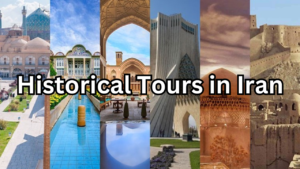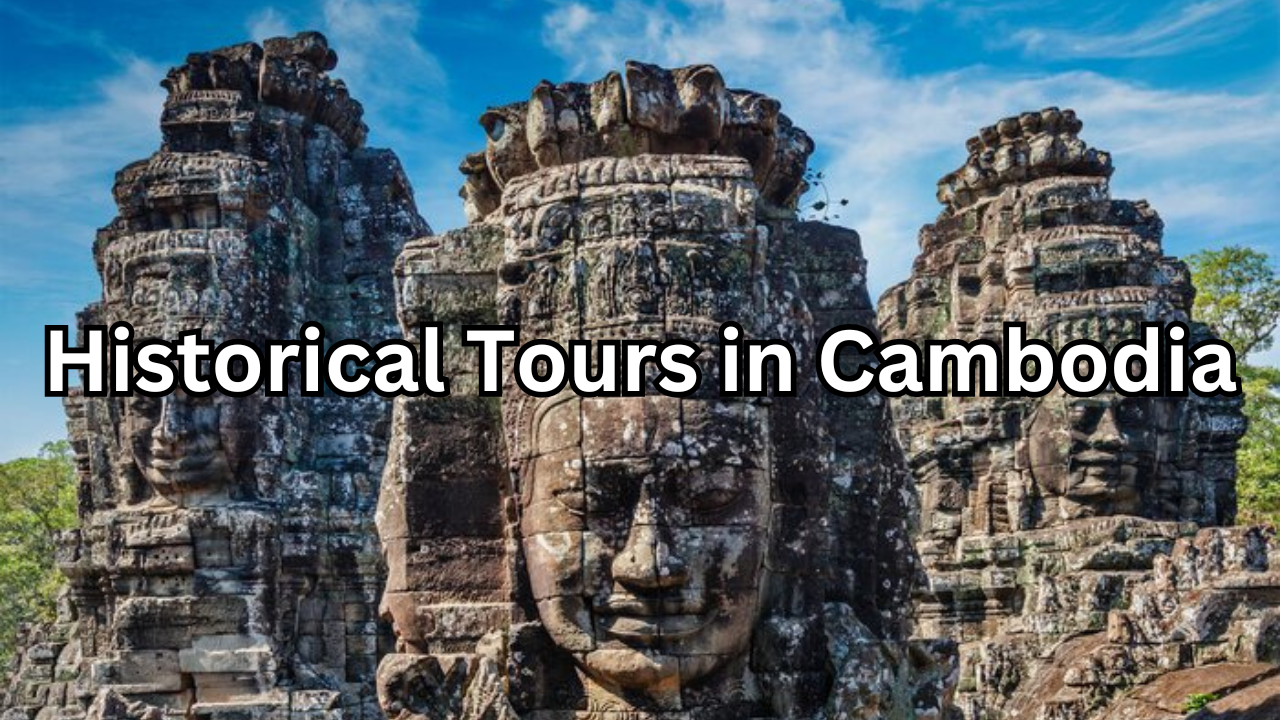
Table of Contents
Introduction to Historical Tours in Cambodia
Cambodia’s rich history and cultural heritage make it a fascinating destination for historical tours. From ancient temple complexes to colonial architecture and remnants of more recent historical events, Cambodia offers a diverse range of experiences for history enthusiasts and curious travelers alike.
Historical tours in Cambodia provide a unique opportunity to delve into the country’s past, spanning from the magnificent Angkor Wat temples, remnants of the Khmer Empire, to the more recent history marked by the Khmer Rouge regime and its aftermath.
In this guide, we will explore the various historical tours available in Cambodia, highlighting key destinations, significant sites, and the insights they offer into Cambodia’s vibrant history. Whether you’re interested in ancient civilizations, colonial architecture, or modern history, Cambodia’s historical tours have something to offer for everyone. Let’s embark on a journey through Cambodia’s captivating past.
Brief Overview of Cambodia’s Rich Historical and Cultural Heritage
Cambodia boasts a rich and diverse historical and cultural heritage that spans millennia. The country’s history is deeply rooted in the powerful Khmer Empire, which flourished from the 9th to the 15th centuries, leaving behind magnificent temple complexes such as Angkor Wat, Angkor Thom, and Bayon. These ancient temples are not only architectural marvels but also symbols of Cambodia’s past glory and cultural achievements.
Beyond the Khmer Empire, Cambodia’s history includes periods of influence from neighboring civilizations, such as the Cham and the Thai. The country also experienced French colonial rule in the 19th and 20th centuries, leaving behind a legacy of colonial architecture, urban planning, and cultural influences that are still evident today.
In more recent times, Cambodia faced the tragic era of the Khmer Rouge regime in the 1970s, resulting in immense human suffering and lasting scars on the nation. Understanding Cambodia’s history requires exploring these various epochs and their impact on the country’s culture, society, and identity.
Importance of Historical Tours in Understanding Cambodia’s Past
Historical tours play a crucial role in helping visitors and locals alike understand Cambodia’s complex and layered history. Here are some reasons why historical tours are invaluable in this regard:
- Preservation of Heritage: Historical tours contribute to the preservation and conservation of Cambodia’s historical sites, ensuring that these cultural treasures are protected for future generations.
- Educational Insights: Knowledgeable guides provide historical context, stories, and insights that deepen visitors’ understanding of Cambodia’s past, including its achievements, challenges, and resilience.
- Cultural Appreciation: By exploring ancient temples, colonial buildings, and traditional villages, tourists gain a greater appreciation for Cambodia’s diverse cultural heritage, including its art, architecture, religion, and customs.
- Holistic Perspective: Historical tours offer a holistic perspective on Cambodia’s history, covering ancient civilizations, colonial legacies, modern developments, and the socio-political complexities that have shaped the nation.
- Fostering Dialogue: Engaging with Cambodia’s history through tours fosters dialogue, empathy, and cross-cultural understanding, promoting reconciliation and mutual respect among visitors and local communities.
Overall, historical tours not only provide enriching travel experiences but also contribute to heritage conservation, education, and cultural exchange, making them an essential aspect of exploring Cambodia’s past and present.
Angkor Wat Archaeological Park Tour
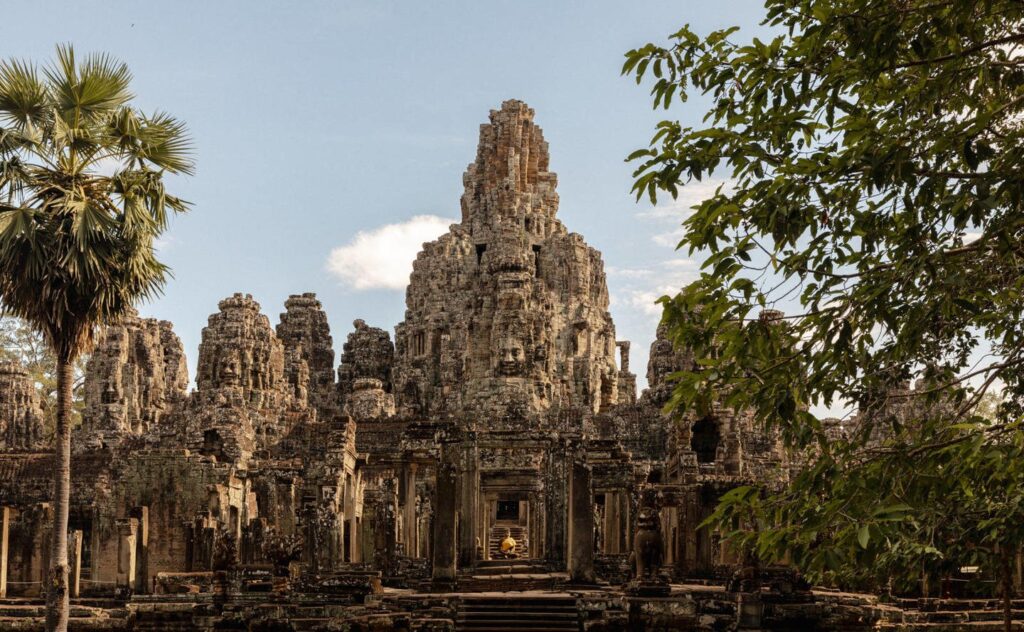
Embarking on an Angkor Wat Archaeological Park tour is like stepping into a realm of ancient wonders and historical marvels. As the crown jewel of Cambodian heritage, Angkor Wat stands as the world’s largest religious monument and a testament to the architectural brilliance of the Khmer Empire. Exploring this vast archaeological park unveils a tapestry of intricately carved temples, sprawling ruins, and serene landscapes that whisper tales of a bygone era. From the grandeur of Angkor Wat itself to the enigmatic smiling faces of Bayon Temple and the captivating tree roots of Ta Prohm, each site within the park carries a unique charm and historical significance. Guided tours offer invaluable insights into the religious, cultural, and artistic aspects of Angkor’s legacy, allowing visitors to unravel the mysteries of this ancient civilization while marveling at its enduring beauty.
Description of Angkor Wat and its significance
Angkor Wat, the crown jewel of Angkor Archaeological Park, is a sprawling temple complex that embodies the pinnacle of Khmer architectural and artistic achievement. Built in the 12th century by King Suryavarman II, Angkor Wat is dedicated to the Hindu god Vishnu and later transformed into a Buddhist temple. Its iconic silhouette, with its central tower rising majestically above a series of concentric galleries and moats, symbolizes Mount Meru, the mythical abode of the gods in Hindu cosmology. The intricate bas-reliefs adorning its walls depict scenes from Hindu epics like the Ramayana and Mahabharata, offering a glimpse into ancient Khmer mythology and history. Angkor Wat’s significance lies not only in its architectural grandeur but also in its cultural and religious importance as a symbol of Cambodia’s spiritual heritage.
Other key sites within Angkor Archaeological Park
- Angkor Thom: The fortified city of Angkor Thom, with its imposing South Gate adorned with stone faces, encompasses several notable sites, including the Bayon Temple with its iconic smiling faces, the Terrace of the Elephants showcasing intricate carvings, and the Terrace of the Leper King adorned with mysterious figures.
- Ta Prohm: Famously known as the “Tomb Raider” temple, Ta Prohm is a captivating sight where ancient ruins are intertwined with the roots of massive trees, creating a surreal and hauntingly beautiful atmosphere. This temple exemplifies the harmonious blend of nature and architecture seen throughout Angkor.
- Banteay Srei: Located slightly outside the main Angkor complex, Banteay Srei is renowned for its exquisite pink sandstone carvings, showcasing intricate details and delicate craftsmanship that are unparalleled in Khmer artistry.
- Preah Khan: A sprawling temple complex engulfed by lush vegetation, Preah Khan features impressive galleries, courtyards, and decorative motifs, offering a glimpse into the architectural grandeur of the Khmer Empire.
Guided tours and experiences available
Guided tours in Angkor Archaeological Park provide a deeper understanding of its history, architecture, and cultural significance. Knowledgeable guides lead visitors through the intricate corridors of Angkor Wat, unraveling its mysteries and sharing insights into Khmer mythology and religious practices. Additionally, guided tours often include visits to other key sites within the park, such as Angkor Thom, Ta Prohm, Banteay Srei, and Preah Khan, allowing visitors to appreciate the diversity and richness of Angkor’s heritage. Sunset tours, sunrise expeditions, and specialized photography tours are also available, catering to different interests and offering memorable experiences amidst the ancient splendor of Angkor.
Phnom Penh Historical Tour
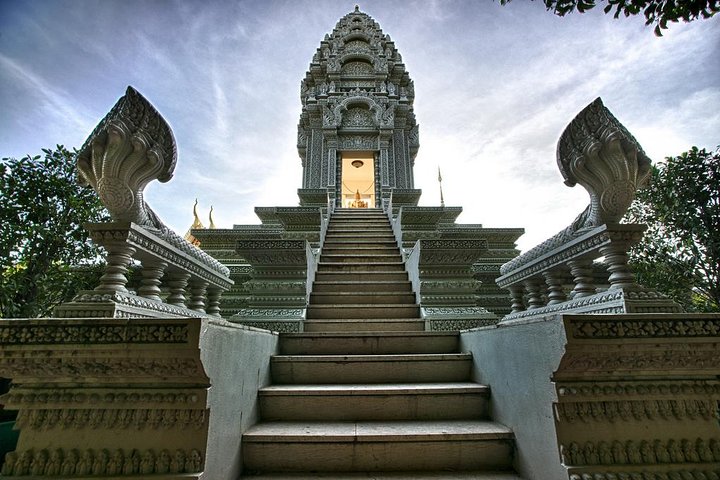
Embarking on a Phnom Penh Historical Tour is a captivating journey through Cambodia’s tumultuous past and vibrant present. As the capital city, Phnom Penh is a living testament to Cambodia’s complex history, blending ancient traditions with colonial legacies and modern developments. The tour typically begins with a visit to the magnificent Royal Palace, a symbol of Cambodia’s monarchy and architectural splendor. Inside, visitors can marvel at the Silver Pagoda, adorned with precious treasures and a stunning Emerald Buddha statue.
Continuing the historical exploration, the tour often includes a somber yet essential stop at the Tuol Sleng Genocide Museum, also known as S-21. This former high school turned prison during the Khmer Rouge era serves as a haunting reminder of Cambodia’s darkest days, offering insights into the atrocities committed and honoring the memories of the victims.
Another significant site on the Phnom Penh Historical Tour is the Choeung Ek Genocidal Center, commonly known as the Killing Fields. This memorial site pays tribute to the millions who lost their lives during the Khmer Rouge regime, providing a sobering yet crucial experience to understand Cambodia’s recent history and resilience.
Amidst the historical landmarks, the tour also explores Phnom Penh’s colonial heritage, with stops at the French-inspired Central Market and elegant boulevards lined with colonial-era buildings. These architectural gems offer glimpses into Phnom Penh’s past as a thriving colonial city and its evolution into a bustling metropolis.
Guided by knowledgeable historians or local experts, the Phnom Penh Historical Tour provides valuable context, stories, and reflections on Cambodia’s journey from ancient kingdoms to colonial rule, civil unrest, and eventual recovery. It’s a poignant and enlightening experience that invites visitors to honor the past, appreciate the present, and look toward Cambodia’s future with hope and understanding.
Historical Highlights of Phnom Penh
Phnom Penh, the capital city of Cambodia, is steeped in a rich tapestry of history that spans centuries. Its strategic location along the banks of the Tonle Sap and Mekong rivers has made it a focal point of cultural exchange, trade, and political power throughout history. From the glory days of the Khmer Empire to the colonial era and modern times, Phnom Penh’s historical highlights showcase the resilience and cultural heritage of Cambodia.
Key Sites such as the Royal Palace, Silver Pagoda, and Tuol Sleng Genocide Museum
- Royal Palace: A symbol of Cambodia’s monarchy and architectural grandeur, the Royal Palace is a must-visit on any historical tour of Phnom Penh. Built-in the 19th century, it houses the Throne Hall, Moonlight Pavilion, and other opulent structures that reflect traditional Khmer design and craftsmanship.
- Silver Pagoda: Located within the Royal Palace complex, the Silver Pagoda is renowned for its floor adorned with 5,000 silver tiles and its collection of precious artifacts, including a life-sized gold Buddha statue adorned with diamonds.
- Tuol Sleng Genocide Museum (S-21): A stark contrast to the opulence of the Royal Palace, Tuol Sleng Genocide Museum stands as a haunting reminder of Cambodia’s tragic past under the Khmer Rouge regime. This former school turned prison and interrogation center tells the harrowing stories of those who suffered during this dark chapter of history.
Insights into Cambodia’s Modern History and Recent Past
Beyond the ancient and colonial eras, a historical tour of Phnom Penh offers insights into Cambodia’s modern history and recent past, particularly focusing on the Khmer Rouge era and its aftermath. Visiting sites like the Tuol Sleng Genocide Museum and the Choeung Ek Genocidal Center (Killing Fields) provides a somber yet essential understanding of the atrocities committed and the resilience of the Cambodian people.
Additionally, exploring Phnom Penh’s neighborhoods, markets, and cultural institutions offers glimpses into Cambodia’s ongoing cultural revival, economic development, and social transformation. From traditional arts and crafts to contemporary art galleries and bustling street food scenes, Phnom Penh embodies the fusion of tradition and modernity that defines Cambodia today.
Battambang Colonial Architecture Tour
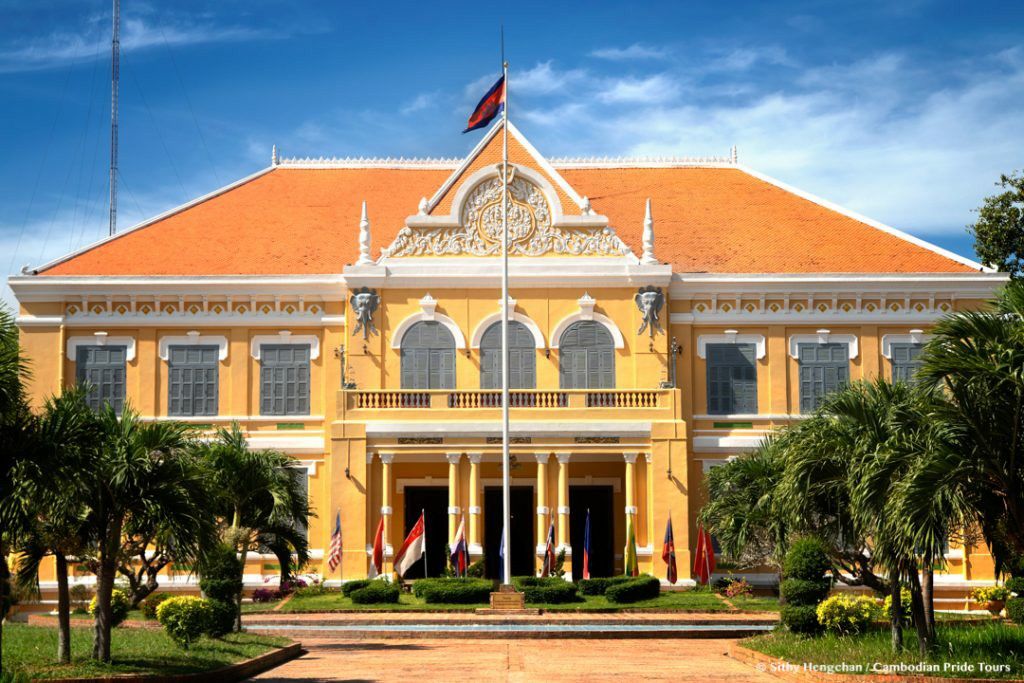
Embarking on a Battambang Colonial Architecture Tour is like stepping back in time to Cambodia’s colonial era, where French influence left an indelible mark on the city’s architecture and cultural landscape. Battambang, located in northwestern Cambodia, boasts a wealth of well-preserved colonial buildings that reflect a blend of French and Khmer architectural styles.
The tour typically begins with a stroll through Battambang’s Old Town, where charming colonial-era buildings line the streets. These buildings, with their shuttered windows, balconies, and intricate facades, offer a glimpse into the city’s past as a bustling colonial trading hub.
One of the highlights of the tour is the Governor’s Residence, an elegant colonial mansion that once housed French colonial administrators. Its graceful columns, high ceilings, and spacious rooms evoke a sense of grandeur from a bygone era.
Another notable stop on the Battambang Colonial Architecture Tour is Psar Nat, the city’s central market. Here, visitors can admire the market’s colonial-era architecture while exploring its vibrant stalls selling everything from fresh produce to local handicrafts.
The tour also includes visits to historic sites such as Wat Damrey Sar, a Buddhist temple with a blend of Khmer and colonial architectural elements, and the Battambang Provincial Museum, which showcases artifacts and exhibits related to the region’s history and culture.
Guided by knowledgeable locals or historians, the Battambang Colonial Architecture Tour offers insights into the colonial period’s impact on Battambang’s urban development, cultural heritage, and identity. It’s a journey that invites visitors to appreciate the beauty of Battambang’s colonial architecture while gaining a deeper understanding of its historical significance in Cambodia’s story.
Introduction to Battambang and its Colonial History
Nestled in the heart of northwestern Cambodia, Battambang is a city steeped in history and cultural heritage. Known for its picturesque countryside, vibrant arts scene, and rich colonial legacy, Battambang offers a unique perspective on Cambodia’s past and present. The city’s colonial history dates back to the late 19th and early 20th centuries when French colonialists established their presence in Cambodia. Battambang, with its strategic location along the Sangker River, became a center for trade, administration, and cultural exchange during this period. Today, remnants of Battambang’s colonial past can be seen in its well-preserved French colonial buildings, charming streetscapes, and blend of Khmer and French architectural styles.
Exploration of French Colonial Buildings and Architecture
The Exploration of French Colonial Buildings and Architecture in Battambang is a journey back in time to an era of elegance, sophistication, and European influence. The tour takes visitors through Battambang’s Old Town, where they can admire a plethora of colonial-era buildings that reflect the city’s colonial heritage. From quaint cafes and boutiques to government offices and private residences, each building tells a story of Battambang’s past as a thriving colonial outpost.
Key highlights of the tour include the Governor’s Residence, a majestic colonial mansion with its characteristic verandas and ornate detailing, and the Central Market (Psar Nat), an architectural gem showcasing the fusion of French and Khmer design elements.
The tour also explores lesser-known colonial buildings tucked away in Battambang’s neighborhoods, offering a deeper understanding of the city’s architectural evolution and cultural fusion.
Walking or Cycling Tour Experiences
Immersing oneself in Battambang’s colonial history is best experienced through walking or cycling tours, allowing visitors to leisurely explore the city’s streets, alleys, and hidden corners. Walking tours take visitors on a guided stroll through Battambang’s Old Town, providing up-close views of colonial buildings, historical landmarks, and local life. Cyclists can opt for guided cycling tours that venture further into Battambang’s outskirts, where charming villages, rice paddies, and ancient temples await.
Both walking and cycling tours offer opportunities to interact with locals, discover hidden gems, and capture the essence of Battambang’s colonial charm. Whether on foot or on two wheels, the Exploration of French Colonial Buildings and Architecture in Battambang promises a memorable and enriching experience for history buffs and cultural enthusiasts alike
Siem Reap Countryside Tour
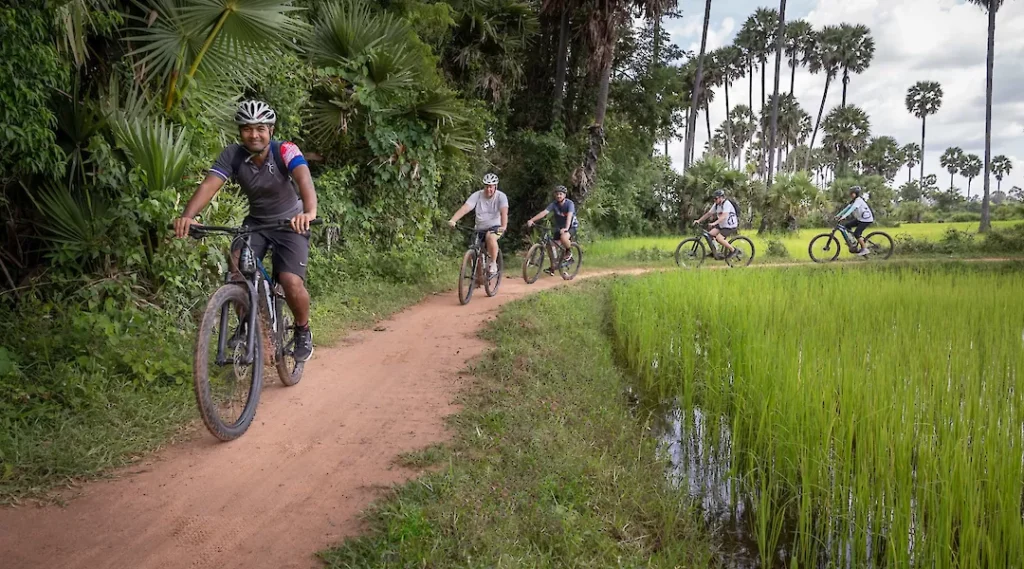
Embarking on a Siem Reap Countryside Tour is a delightful escape into the serene landscapes, traditional villages, and hidden gems that lie beyond the bustling temples of Angkor Wat. Siem Reap, known primarily for its ancient archaeological wonders, also offers a glimpse into Cambodia’s rural life, cultural heritage, and natural beauty.
The tour typically begins with a scenic drive through the picturesque countryside surrounding Siem Reap, where verdant rice paddies, palm-lined roads, and rural communities create a tranquil atmosphere. Along the way, visitors may encounter friendly locals going about their daily activities, providing a glimpse into Cambodia’s agrarian lifestyle.
One of the highlights of the Siem Reap Countryside Tour is the visit to traditional villages, where visitors can experience authentic Khmer culture and hospitality. From witnessing traditional crafts like pottery making and silk weaving to interacting with villagers and learning about their customs, the village visits offer immersive insights into rural Cambodian life.
The tour may also include stops at lesser-known temples and ancient ruins nestled in the countryside, such as the intricately carved Banteay Srei temple or the peaceful Preah Khan temple complex. These sites showcase the architectural diversity and historical significance beyond the more famous Angkor temples.
A boat excursion on the tranquil waters of Tonle Sap Lake is often a highlight of the Siem Reap Countryside Tour. The lake, Southeast Asia largest freshwater lake, is teeming with biodiversity and seasonal floating villages, providing a unique perspective on Cambodia’s natural environment and the interconnectedness of water-based livelihoods.
Guided by knowledgeable locals or experienced guides, the Siem Reap Countryside Tour offers a balance of cultural immersion, historical exploration, and scenic beauty. Whether by car, bicycle, or boat, this tour invites visitors to step off the beaten path and discover the hidden treasures that lie in Siem Reap’s enchanting countryside.
Beyond Angkor Wat: Exploring Siem Reap’s Countryside
While Angkor Wat’s grandeur draws millions of visitors to Siem Reap, the city’s countryside offers a tranquil retreat into Cambodia’s rural heart. Embarking on a Siem Reap Countryside Tour is like peeling back layers of history, culture, and natural beauty beyond the iconic temples. The lush countryside, dotted with rice paddies, palm trees, and quaint villages, provides a serene backdrop for a deeper exploration of Cambodia’s soul.
Visits to Traditional Villages, Banteay Srei Temple, and Tonle Sap Lake
The Siem Reap Countryside Tour ventures into traditional villages, where time seems to stand still amid age-old customs and crafts. Visitors have the chance to witness artisans at work, from skilled pottery makers shaping clay to weavers crafting intricate silk textiles. These encounters offer a firsthand experience of Cambodia’s living heritage and the resilience of rural communities.
A highlight of the tour is the enchanting Banteay Srei temple, renowned for its exquisite pink sandstone carvings that depict Khmer mythology and religious tales. This gem of Angkor’s outskirts showcases the intricate artistry and architectural finesse of the Khmer Empire, leaving a lasting impression on visitors.
A boat excursion on the serene waters of Tonle Sap Lake unveils a different facet of rural Cambodia. The lake, a UNESCO Biosphere Reserve, teems with biodiversity and seasonal floating villages inhabited by fishing communities. It’s a glimpse into a way of life deeply intertwined with nature, where the rhythm of the lake dictates daily existence.
Cultural and Historical Insights of Rural Cambodia
Exploring Siem Reap’s countryside isn’t just about scenic beauty; it’s a journey of cultural and historical discovery. Guided by knowledgeable locals or experienced guides, visitors gain insights into rural Cambodia’s traditions, beliefs, and historical legacies. Stories of ancient temple builders, agricultural practices, and local folklore add depth to the tour, fostering a deeper appreciation for Cambodia’s rich cultural tapestry.
Moreover, interactions with villagers and community initiatives provide a nuanced understanding of rural life’s challenges and aspirations. Visitors leave with not just memories of stunning landscapes but also a newfound respect for the resilience and vibrancy of rural Cambodia’s heritage.
Kampong Cham and Kratie Tour
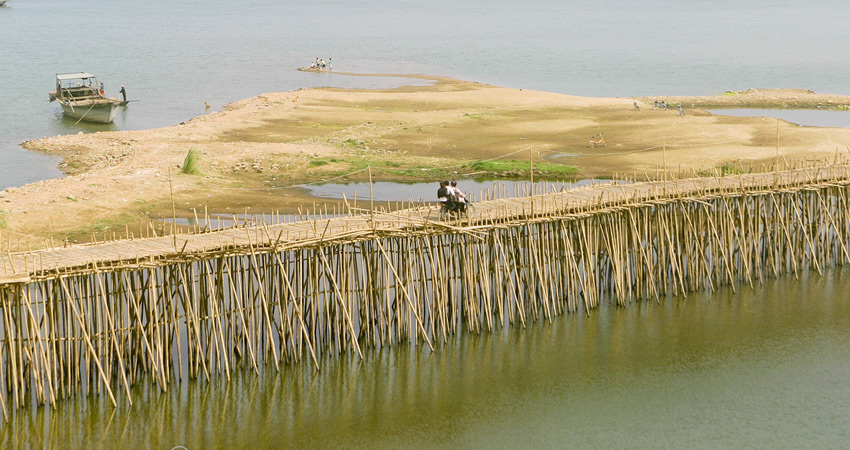
The Kampong Cham and Kratie Tour offers a captivating journey through Cambodia’s northeastern provinces, where the Mekong River weaves a tapestry of culture, history, and natural beauty. Kampong Cham and Kratie, though lesser-known compared to Siem Reap or Phnom Penh, hold hidden gems waiting to be discovered by adventurous travelers.
Starting in Kampong Cham, the tour delves into the province’s rich historical and cultural heritage. The town’s French colonial architecture, bustling markets, and tranquil riverside promenades provide a glimpse into daily life in provincial Cambodia. Visitors can explore ancient temples like Wat Nokor, a 11th-century marvel adorned with intricate carvings and a blend of Khmer and Hindu architectural styles.
Continuing along the Mekong River, the tour ventures into Kratie province, renowned for its serene landscapes and rare Irrawaddy dolphins. A highlight of the tour is a boat excursion to Kampi, where visitors can witness these gentle giants in their natural habitat, a unique and unforgettable experience.
In addition to wildlife encounters, the Kampong Cham and Kratie Tour offers cultural immersion through visits to traditional villages along the Mekong. Interactions with local communities provide insights into rural Cambodian life, from traditional fishing techniques to handicrafts like silk weaving and pottery making.
Guided by knowledgeable locals or experienced guides, the tour also delves into the region’s historical significance, including remnants of French colonial influence and Khmer architectural treasures. Stops at Kratie’s pagodas, such as Wat Rokakandal, offer spiritual and architectural insights into Cambodia’s Buddhist heritage.
Overall, the Kampong Cham and Kratie Tour is a blend of cultural discovery, natural exploration, and historical insights, offering a deeper appreciation for Cambodia’s diverse landscapes and heritage beyond the well-trodden tourist paths.
Overview of Kampong Cham and Kratie Provinces
Nestled along the banks of the majestic Mekong River, Kampong Cham and Kratie provinces are hidden gems in northeastern Cambodia, offering a blend of historical richness, natural beauty, and cultural heritage. Kampong Cham, the largest province in Cambodia, is known for its fertile landscapes, traditional villages, and ancient temples. Meanwhile, Kratie province is famed for its serene riverside settings, rare Irrawaddy dolphins, and historical sites that reflect Cambodia’s diverse past.
Historical Sites such as Wat Nokor Temple and French Colonial Architecture
One of the historical highlights of the Kampong Cham and Kratie Tour is the visit to Wat Nokor temple, an architectural masterpiece dating back to the 11th century. This ancient temple, nestled within a modern pagoda, showcases intricate carvings, bas-reliefs, and a unique blend of Khmer and Hindu architectural styles, providing a glimpse into Cambodia’s religious and cultural heritage.
The tour also includes exploration of French colonial architecture in both provinces, with charming buildings, boulevards, and structures that reflect Cambodia’s colonial past. In Kampong Cham, visitors can admire colonial-era landmarks such as the old market, colonial houses, and the French-built bridge over the Mekong River. In Kratie, remnants of French influence can be seen in the town’s architecture and historic buildings, adding to the region’s cultural diversity.
Mekong River and Rural Life Experiences
The Mekong River serves as a lifeline for both Kampong Cham and Kratie provinces, shaping their landscapes, economies, and ways of life. A boat excursion along the Mekong offers panoramic views of lush greenery, fishing villages, and daily activities along the riverbanks. Visitors can immerse themselves in rural life experiences, from observing traditional fishing techniques to interacting with local communities engaged in agriculture, handicrafts, and river-based livelihoods.
Beyond the river, the tour delves into the heart of rural Cambodia, where time seems to slow down amidst rice paddies, palm groves, and traditional Khmer stilt houses. Cultural exchanges with villagers, visits to local markets, and opportunities to participate in village activities provide a deeper understanding of Cambodia’s rural landscapes and the resilience of its people.
Overall, the Kampong Cham and Kratie Tour offers a multifaceted exploration of Cambodia’s northeastern provinces, combining historical intrigue, natural wonders, and authentic cultural experiences along the banks of the iconic Mekong River.
Kampot and Kep Heritage Tour
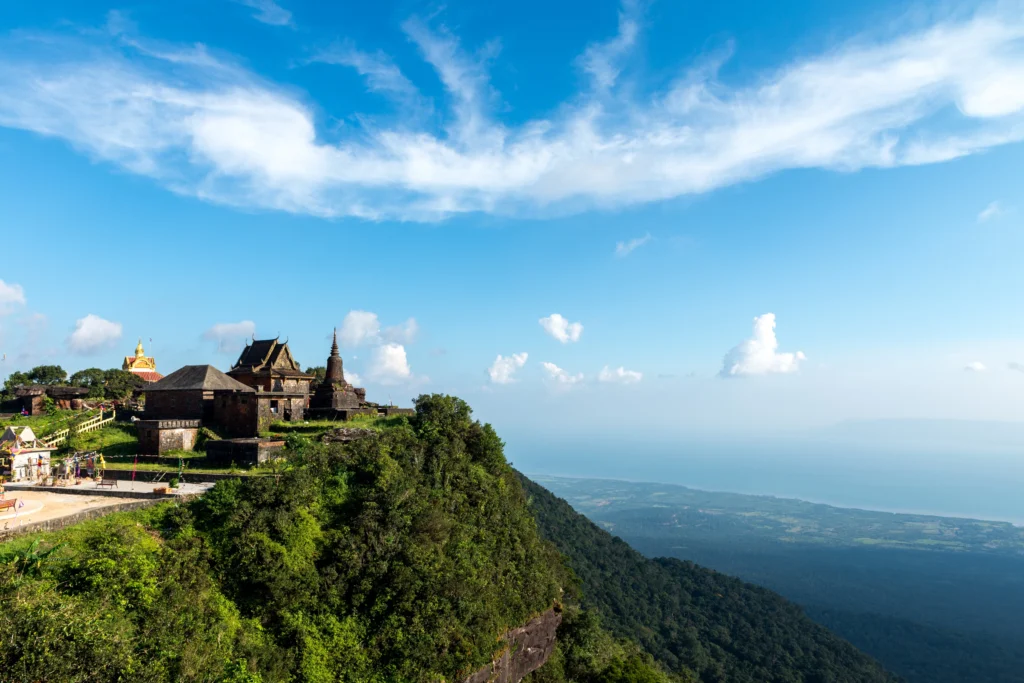
The Kampot and Kep Heritage Tour unveils the hidden gems of Cambodia’s coastal region, where colonial charm, natural beauty, and culinary delights converge. Kampot and Kep, situated along the Gulf of Thailand, offer a unique blend of historical heritage, serene landscapes, and culinary delights that captivate visitors seeking a more laid-back and off-the-beaten-path experience.
Starting in Kampot, the tour delves into the town’s colonial past, evident in its well-preserved French colonial architecture. Strolling along the riverside promenade, visitors can admire colonial-era buildings, art deco facades, and charming cafes that exude an old-world charm. The tour often includes stops at historic sites like the Old Market, Kampot Provincial Museum, and the iconic Durian Roundabout, each offering insights into Kampot’s cultural heritage and trading history.
Continuing to Kep, the tour transitions into a coastal haven known for its tranquil beaches, seafood delicacies, and abandoned French colonial villas. Kep was once a thriving resort town for the French elite, and remnants of its glamorous past can still be seen in the dilapidated yet picturesque villas that dot the coastline. A visit to the Kep Crab Market is a must, where visitors can savor freshly caught seafood and soak in the vibrant atmosphere of this seaside town.
The Kampot and Kep Heritage Tour also explores the region’s natural beauty, with stops at Kep National Park offering panoramic views of the coastline and surrounding countryside. The park’s hiking trails lead to viewpoints, hidden caves, and lush forests, providing a refreshing escape into nature.
Guided by knowledgeable locals or experienced guides, the tour offers cultural insights into Kampot and Kep’s history, architecture, and local traditions. From learning about pepper cultivation in Kampot’s pepper plantations to indulging in Kep’s famous crab dishes, visitors are immersed in the region’s heritage and culinary delights.
Overall, the Kampot and Kep Heritage Tour is a journey of discovery, blending colonial nostalgia, coastal serenity, and gastronomic pleasures in Cambodia’s charming coastal region.
Historical Charm of Kampot and Kep
Kampot and Kep, nestled along Cambodia’s southern coast, exude a captivating historical charm that transports visitors to a bygone era of colonial elegance and seaside tranquility. Kampot, with its winding river, colonial buildings, and laid-back ambiance, reflects its past as a bustling French colonial trading center. Meanwhile, Kep, once a retreat for the French elite, retains remnants of its glamorous past in the form of abandoned colonial villas and a relaxed coastal vibe. Together, these towns offer a glimpse into Cambodia’s colonial heritage and coastal allure.
French Colonial Architecture, Pepper Plantations, and Rabbit Island Excursion
The Kampot and Kep Heritage Tour delves into the region’s architectural legacy, with a focus on French colonial buildings that adorn Kampot’s streets and waterfront. Visitors can admire the ornate facades, shuttered windows, and nostalgic charm of these buildings, which serve as reminders of Kampot’s trading heyday.
A highlight of the tour is a visit to Kampot’s renowned pepper plantations, where visitors can learn about the cultivation of Kampot pepper, celebrated for its exceptional flavor and quality. Guided tours of pepper farms offer insights into the harvesting, drying, and processing techniques that make Kampot pepper prized worldwide.
The tour also includes an excursion to Rabbit Island (Koh Tonsay), a serene paradise just off Kep’s coast. Accessible by boat, Rabbit Island offers pristine beaches, crystal-clear waters, and a laid-back atmosphere perfect for relaxation and exploration. Visitors can swim, snorkel, or simply unwind on the beach while savoring fresh seafood and panoramic views of the Gulf of Thailand.
Coastal Historical Perspective and Unique Experiences
The Kampot and Kep Heritage Tour provides a coastal historical perspective, blending insights into Cambodia’s colonial past with unique experiences along the coast. Guided tours of colonial landmarks, pepper plantations, and Rabbit Island offer a multifaceted exploration of the region’s heritage and natural beauty.
Additionally, the tour allows visitors to immerse themselves in coastal life, from witnessing traditional fishing techniques to sampling local delicacies like Kep’s famous crab dishes. Cultural exchanges with locals, visits to seaside markets, and leisurely walks along the waterfront offer a deeper understanding of Kampot and Kep’s cultural richness and maritime traditions.
Overall, the Kampot and Kep Heritage Tour promises a harmonious blend of historical discovery, coastal charm, and authentic experiences, making it a memorable journey into Cambodia’s captivating coastal region.
Banteay Chhmar Temple Tour
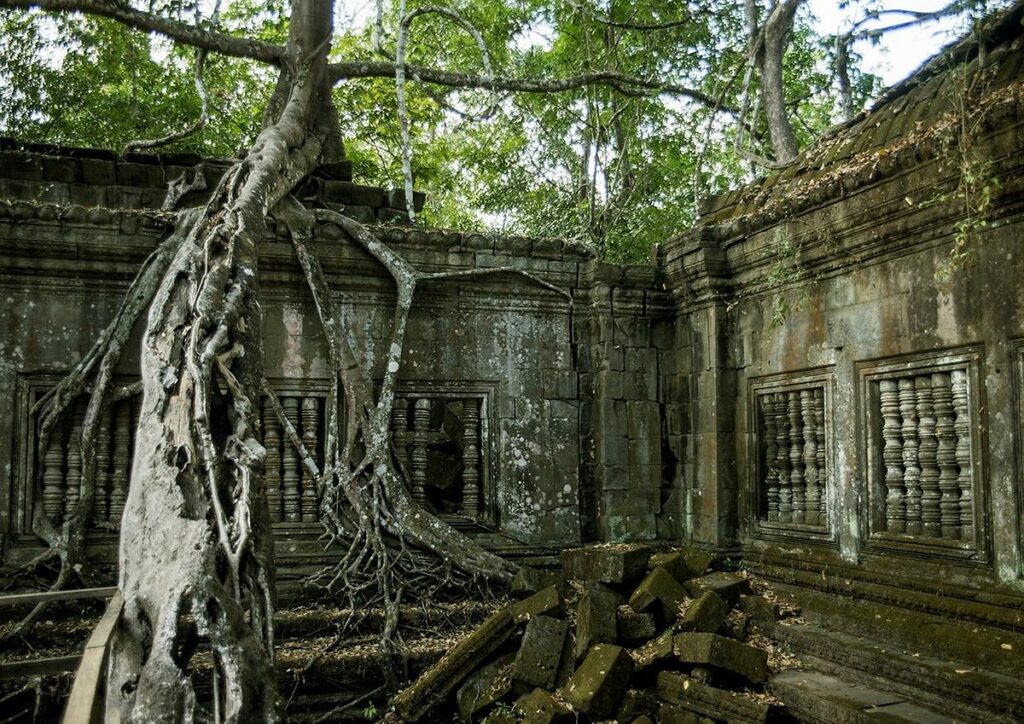
The Banteay Chhmar Temple Tour is a captivating journey into the heart of Cambodia’s ancient Khmer Empire, offering a glimpse into the grandeur and architectural mastery of one of the region’s lesser-known temple complexes. Located in Banteay Meanchey province, Banteay Chhmar Temple stands as a testament to the Khmer civilization’s artistic and cultural achievements, yet it remains relatively undiscovered by mainstream tourism, making it a hidden gem for history enthusiasts and adventurers.
The tour begins with a scenic drive through rural Cambodia, passing picturesque landscapes, traditional villages, and rice paddies that evoke a sense of timeless beauty. Upon reaching Banteay Chhmar Temple, visitors are greeted by the temple’s imposing walls, intricate carvings, and ancient ruins that whisper tales of a bygone era.
Banteay Chhmar Temple, built in the late 12th century during the reign of King Jayavarman VII, is renowned for its elaborate bas-reliefs depicting scenes from Hindu mythology, historical events, and daily life in ancient Khmer society. The temple’s central sanctuary, once adorned with a giant stone face similar to those at Bayon Temple, reflects the architectural grandeur and religious significance of the Khmer Empire.
Guided by knowledgeable locals or experienced guides, the Banteay Chhmar Temple Tour offers insights into the temple’s history, symbolism, and restoration efforts. Visitors can explore the temple’s galleries, towers, and hidden chambers, marveling at the intricate stonework and artistic details that adorn every corner.
Beyond the temple itself, the tour may include visits to nearby villages, where visitors can interact with local communities, learn about their traditions, and witness traditional crafts such as silk weaving or pottery making. These cultural exchanges add depth to the tour, providing a holistic understanding of Cambodia’s past and present.
Overall, the Banteay Chhmar Temple Tour is a journey of discovery and appreciation, inviting visitors to unravel the mysteries of an ancient civilization while experiencing the warmth and hospitality of rural Cambodia. It’s a chance to step off the beaten path and uncover the hidden treasures of this remarkable historical site.
Introduction to Banteay Chhmar Temple Complex
Situated in the northwestern part of Cambodia, the Banteay Chhmar Temple Complex is a hidden jewel of the Khmer Empire’s architectural and artistic prowess. Built in the late 12th century during the reign of King Jayavarman VII, this sprawling temple complex once stood as a testament to the grandeur and sophistication of the Khmer civilization. Despite its remote location in Banteay Meanchey province, the temple complex has gained recognition for its historical importance and intricate stone carvings, attracting adventurous travelers and history enthusiasts seeking to uncover its secrets.
Historical and Architectural Significance of the Temple
Banteay Chhmar Temple holds immense historical and architectural significance within the context of the Khmer Empire. As one of the largest temple complexes outside Angkor, it served as a royal sanctuary and a center of religious and political activities during its heyday. The temple’s design, characterized by its towering prasats (towers), galleries, and moat, reflects the Khmer Empire’s mastery of temple construction and urban planning.
What sets Banteay Chhmar apart are its extensive bas-reliefs and intricate carvings, depicting scenes from Hindu mythology, historical battles, celestial beings, and daily life in ancient Khmer society. These artistic expressions not only showcase the Khmer Empire’s cultural richness but also provide invaluable insights into the beliefs, customs, and social hierarchy of that era.
Remote Location and Unique Insights into Khmer History
The remote location of Banteay Chhmar Temple Complex adds to its allure, offering visitors a chance to explore a lesser-known archaeological site away from the crowds. This remoteness also provides unique insights into Khmer history, allowing for a more intimate and immersive experience amidst the temple’s ancient ruins and serene surroundings.
Visitors to Banteay Chhmar gain a deeper appreciation for the Khmer Empire’s legacy, from its architectural achievements to its religious and cultural practices. Guided tours or interactions with local experts offer fascinating narratives about the temple’s history, its significance to the Khmer rulers, and the challenges and triumphs of preserving such a historical treasure.
Overall, the Banteay Chhmar Temple Complex stands as a testament to Cambodia’s rich heritage and serves as a gateway to unlocking the mysteries of the Khmer Empire’s golden age. Its remote location, combined with its historical and architectural splendor, offers a truly immersive journey into the heart of Khmer history and culture.
Preah Vihear Temple Tour
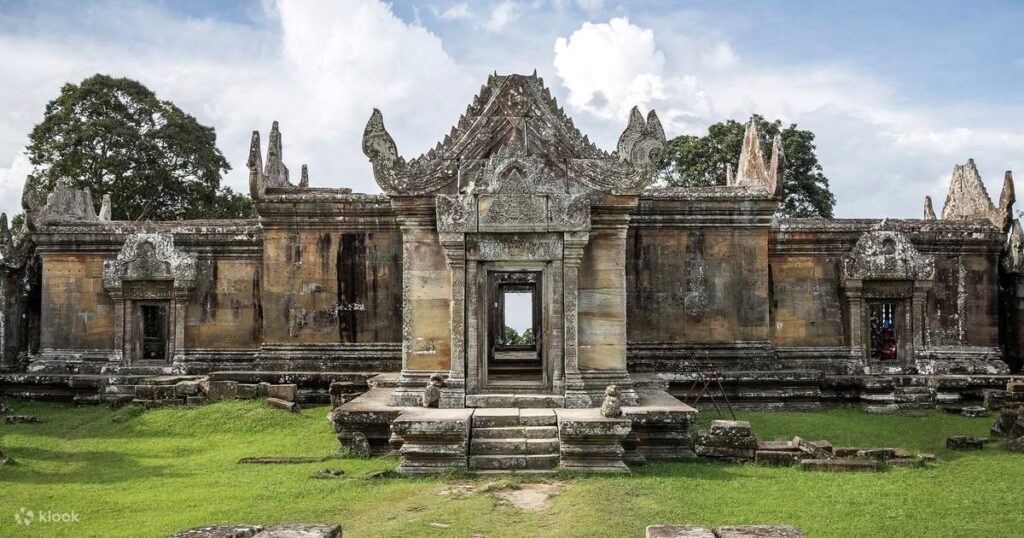
The Preah Vihear Temple Tour is an extraordinary odyssey into the ancient splendor and breathtaking beauty of one of Cambodia’s most iconic and revered temples. Perched atop a dramatic cliff in the Dângrêk Mountains, Preah Vihear Temple stands as a testament to the architectural ingenuity and spiritual devotion of the Khmer Empire. Its remote and majestic location provides a backdrop for an unforgettable journey through history and culture.
The tour begins with a scenic drive through Cambodia’s countryside, offering glimpses of rural life, lush landscapes, and traditional villages along the way. As travelers approach the temple complex, the imposing sight of Preah Vihear Temple perched on the cliff’s edge comes into view, setting the stage for an awe-inspiring exploration.
Preah Vihear Temple, a UNESCO World Heritage Site, dates back to the 9th century and is dedicated to the Hindu god Shiva. Its unique layout follows the natural contours of the cliff, with a series of terraces, pavilions, and courtyards leading to the central sanctuary. The temple’s architecture, adorned with intricate carvings, bas-reliefs, and sculptures, reflects the Khmer Empire’s artistic sophistication and religious fervor.
Guided by knowledgeable locals or experienced guides, visitors embark on a journey through Preah Vihear Temple’s history, symbolism, and cultural significance. The tour includes visits to key areas such as the Gopuras (gateways), libraries, and shrines, each offering insights into Khmer mythology, rituals, and architectural marvels.
Beyond the temple complex itself, the Preah Vihear Temple Tour often includes stops at nearby viewpoints, providing panoramic vistas of the surrounding landscape and revealing the temple’s strategic and awe-inspiring location atop the cliff.
The tour also offers opportunities to interact with local communities, learn about their customs and traditions, and appreciate the region’s natural beauty and biodiversity.
Overall, the Preah Vihear Temple Tour is a journey of discovery, spirituality, and wonder, inviting visitors to delve into Cambodia’s ancient past while marveling at the timeless beauty and majesty of Preah Vihear Temple.
Overview of Preah Vihear Temple and Its Location
Preah Vihear Temple, a UNESCO World Heritage Site, is a magnificent Hindu temple complex perched atop a cliff in the Dângrêk Mountains along the Cambodia-Thailand border. Dating back to the 9th century, this architectural marvel is dedicated to the Hindu deity Shiva and represents the pinnacle of Khmer Empire’s artistic and cultural achievements. Its remote location in Preah Vihear Province offers not only historical and spiritual significance but also breathtaking views of the surrounding countryside.
Breathtaking Views and Historical Significance
The Preah Vihear Temple Tour is renowned for its breathtaking views, especially during sunrise or sunset, when the temple’s silhouette against the backdrop of the Dângrêk Mountains creates a mesmerizing spectacle. The temple’s strategic location atop a cliff provides panoramic vistas of lush forests, rolling hills, and distant horizons, making it a photographer’s paradise and a spiritual retreat.
Historically, Preah Vihear Temple holds immense significance as a symbol of the Khmer Empire’s grandeur and religious devotion. Its architectural design, with a series of terraces, courtyards, and pavilions leading to the central sanctuary, reflects the Khmer’s mastery of temple construction and their reverence for Hindu deities. The temple’s intricate carvings, bas-reliefs, and sculptures narrate tales from Hindu mythology and depict scenes of ancient Khmer life and culture.
Considerations for Accessibility and Safety Due to Its Location Near the Thai Border
Due to its location near the Cambodia-Thailand border, access to Preah Vihear Temple requires careful consideration of accessibility and safety concerns. Travelers should ensure they have the necessary permits and documentation, as well as consult with local authorities or tour operators for the latest information on border regulations and security conditions.
Additionally, the road leading to the temple may be rugged and challenging, requiring a sturdy vehicle and experienced driver for safe transportation. Visitors should also be prepared for a steep ascent to reach the temple complex, which may pose difficulties for individuals with mobility issues.
Despite these considerations, the Preah Vihear Temple Tour offers a once-in-a-lifetime opportunity to witness a cultural treasure nestled in a breathtaking natural setting, making it a truly unforgettable experience for those willing to embark on this extraordinary journey.
Conclusion
Embarking on historical tours in Cambodia is a journey through time, culture, and heritage that leaves an indelible mark on the soul. From the majestic temples of Angkor to the serene countryside of Kampot and the remote wonders of Preah Vihear, each tour offers a unique perspective on Cambodia’s rich history and vibrant present. Exploring ancient ruins, colonial architecture, and traditional villages provides insights into the Khmer Empire’s legacy, French colonial influence, and rural life’s resilience. These tours not only showcase Cambodia’s architectural and artistic achievements but also foster cultural understanding, appreciation, and connection with local communities. While each tour presents its challenges, whether in accessibility or safety, the rewards far outweigh the obstacles. The breathtaking views, historical significance, and unique experiences encountered along the way leave a lasting impression, sparking curiosity, reverence, and a deeper appreciation for Cambodia’s diverse and complex tapestry of history and culture. Historical tours in Cambodia offer a profound and enriching exploration of the past, present, and future, inviting travelers to discover the wonders of a nation steeped in heritage and resilience, waiting to be explored and celebrated.
Read more Historical Tours in Thailand


